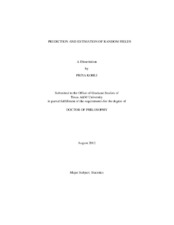| dc.description.abstract | For a stationary two dimensional random field, we utilize the classical Kolmogorov-Wiener theory to develop prediction methodology which requires minimal assumptions on the dependence structure of the random field. We also provide solutions for several non-standard prediction problems which deals with the "modified past," in which a finite number of observations are added to the past. These non-standard prediction problems are motivated by the network site selection in the environmental and geostatistical applications. Unlike the time series situation, the prediction results for random fields seem to be expressible only in terms of the moving average parameters, and attempts to express them in terms of the autoregressive parameters lead to a new and mysterious projection operator which captures the nature of edge-effects. We put forward an approach for estimating the predictor coefficients by carrying out an extension of the exponential models. Through simulation studies and real data example, we demonstrate the impressive performance of our prediction method. To the best of our knowledge, the proposed method is the first to deliver a unified framework for forecasting random fields both in the time and spectral domain without making a subjective choice of the covariance structure.
Finally, we focus on the estimation of the hurst parameter for long range dependence stationary random fields, which draws its motivation from applications in the environmental and atmospheric processes. Current methods for estimation of the Hurst parameter include parametric models like fractional autoregressive integrated moving average models, and semiparametric estimators which are either inefficient or inconsistent. We propose a novel semiparametric estimator based on the fractional exponential spectrum. We develop three data-driven methods which can automatically select the optimal model order for the fractional exponential models. Extensive simulation studies and analysis of Mercer and Hall?s wheat data are used to illustrate the performance of the proposed estimator and model order selection criteria. The results show that our estimator outperforms existing estimators, including the GPH (Geweke and Porter-Hudak) estimator. We show that the proposed estimator is consistent, works for different definitions of long range dependent random fields, is computationally simple and is not susceptible to model misspecification or poor efficiency. | en |


